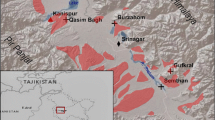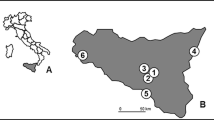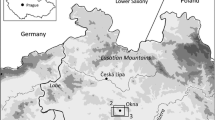Abstract
The ancient Silk Road was a link of economic-cultural exchanges and religious communication between China and the West. Turpan in Xinjiang is an important site on this road and was once one of the areas where Buddhism flourished in the Western Regions. However, the relationship between environment, agricultural activity and Buddhism has received little attention. Here we analyzed the adobe samples from the Bezikelike Grottoes, Turpan for pollen, plant remains and charcoal, and reconstructed a desert steppe vegetation under warm-humid conditions during the period of 9th–13th centuries. In particular the climate of middle 9th–10th centuries was quite pleasant, with a mean annual temperature of 14.2 °C and mean annual precipitation of 880 mm. Ancient people planted economic crops such as grape (Vitis vinifera) and cultivated cereals, including broomcorn millet (Panicum miliaceum), wheat (Triticum aestivum) and barley (Hordeum vulgare var. coeleste), indicating agricultural production activities were well-developed at that time. Further comparison with the oasis environment of the 5th century suggested that the development of agriculture may have created favourable environmental conditions for the flourishing of Buddhism at that time. This finding provides a new perspective for understanding the interaction between environment and humans on the ancient Silk Road.








Similar content being viewed by others
References
Abdirahman H, Bian ZF, Wahap H (2009) Discussion on the water resources and their rational development and utilization in Turpan Basin. J China Hydrol 29:50–54 (in Chinese)
Bi JT, Luo GL, Wang XX, Zhu ZJ (2014) The construction of the spatio-temporal database of the ancient Silk Road within Xinjiang province during the Han and Tang Dynasties. IOP Conf Ser 17:012,169
Bronk Ramsey C (2009) Bayesian analysis of radiocarbon dates. Radiocarbon 51:337–360
Comprehensive Expedition of Xinjiang, Chinese Academy of Sciences, Institute of Botany, CAS (CEXCAS, IBCAS) (1978) Xinjiang vegetation and its utilization. Science Press, Beijing (in Chinese)
Guo BZ (1987) Poaceae (3). In: Wu ZY, Raven PH, Hong DY (eds) Flora of China, Vol 9: Pittosporaceae through Connaraceae. Science Press, Beijing, pp 26–33 (in Chinese)
Hayward HE (1948) The structure of economic plants. Gramineae-continued Triticum spp. (Chap. VI). The Macmillan Co., New York, pp 141–178
Information Department of Beijing Meteorological Center (IDBMC) (1983a) Land Climate Data of China (1951–1980) (Part II). China Meteorological Press, Beijing, pp 4–5, 72–73 (in Chinese)
Information Department of Beijing Meteorological Center (IDBMC) (1983b) Land Climate Data of China (1951–1980) (Part VI). China Meteorological Press, Beijing, pp 4–6, 126–128 (in Chinese)
Information Department of Beijing Meteorological Center (IDBMC) (1984a) Land Climate Data of China (1951–1980) (Part I). China Meteorological Press, Beijing, pp 4–5, 86–87 (in Chinese)
Information Department of Beijing Meteorological Center (IDBMC) (1984b) Land Climate Data of China (1951–1980) (Part III). China Meteorological Press, Beijing, pp 4–6, 107–109 (in Chinese)
Information Department of Beijing Meteorological Center (IDBMC) (1984c) Land Climate Data of China (1951–1980) (Part IV). China Meteorological Press, Beijing, pp 4–6, 99–101 (in Chinese)
Information Department of Beijing Meteorological Center (IDBMC) (1984d) Land Climate Data of China (1951–1980) (Part V). China Meteorological Press, Beijing, pp 4–6, 108–110 (in Chinese)
Institute of Botany, Chinese Academy of Sciences (IBCAS) (1976) Spore Pteridophytorum Sinicorum. Science Press, Beijing (in Chinese)
Jacomet S (1987) Prehistoric cereal finds: a guide to the identification of prehistoric barley wheat finds. Botanical Institute of the University Department of Taxonomy and Geobotany, Basel
Jiang HE, Zhang YB, Li X, Yao YF, Ferguson DK, Lü EG, Li CS (2009) Evidence for early viticulture in China: proof of a grapevine (Vitis vinifera L., Vitaceae) in the Yanghai Tombs, Xinjiang. J Archaeol Sci 36:1,458–1,465
Li YH (1979) Morphology and anatomy of gramineous crops. Shanghai Science and Technology Press, Shanghai, pp 203–293 (in Chinese).
Li JF (1985) Climatic variation of Xinjiang in recent 3000 years. In: University X (ed) A collection of quaternary research papers in the arid region of Xinjiang. Xinjiang People’s Publishing House, Urumqi, pp 1–7 (in Chinese)
Li XQ, Du NQ (1999) The acid-alkali-free analysis of Quaternary pollen. Acta Bot Sin 41:782–784 (in Chinese)
Li YY, Hou SF, Zhao PF (2010) Comparison of different quantification methods for microfossil charcoal concentration and the implication for human activities. Quat Sci 30:356–363 (in Chinese)
Liu HL (1986) Dating of the Bezikelik Grottoes: stage division of the caves based on the Uygur feeding portrait. Dunhuang Res 3:58–67 (in Chinese)
Liu YS, Zetter R, Ferguson DK, Mohr BAR (2007) Discriminating fossil evergreen and deciduous, Quercus pollen: a case study from the Miocene of eastern China. Rev Palaeobot Palynol 145:289–303
Liu FW, Yang YS, Shi ZL, Storozum MJ, Dong GH (2018) Human settlement and wood utilization along the mainstream of Heihe River basin, northwest China in historical period. Quat Int 516:141–148. https://doi.org/10.1016/j.quaint.2018.05.033
Luo CX, Zheng Z, Pan AD, An FZ, Beaudouin C, Huang KY (2007) Distribution of surface soil spore-pollen and its relationship with vegetation in Xinjiang, China. Arid Land Geogr 30:536–543 (in Chinese)
Moore PD, Webb JA, Collinson ME (1991) Pollen analysis, 2nd edn. Blackwell, Oxford, pp 42–46
Mosbrugger V, Utescher T (1997) The coexistence approach: a method for quantitative reconstructions of tertiary terrestrial palaeoclimate data using plant fossils. Palaeogeogr Palaeoclimatol Palaeoecol 134:61–86
Reimer PJ, Bard E, Bayliss A, Beck JW, Blackwell PG, Bronk Ramsey C, Buck CE, Cheng H, Edwards RL, Friedrich M, Grootes PM, Guilderson TP, Haflidason H, Hajdas I, Hatte C, Heaton TJ, Hoffmann DL, Hogg AG, Hughen KA, Kaiser KF, Kromer B, Manning SW, Niu M, Reimer RW, Richards DA, Scott EM, Southon JR, Staff RA, Turney CSM, van der Plicht J (2013) INTCAL13 and MARINE13 radiocarbon age calibration curves 0–50000 years Cal bp. Radiocarbon 55:1,869–1,887
Tang YN, Li X, Yao YF, Ferguson DK, Li CS (2014) Environmental reconstruction of Tuyoq in the fifth century and its bearing on Buddhism in Turpan, Xinjiang, China. PLoS ONE 9:e86,363. https://doi.org/10.1371/journal.pone.0086363
Turpan Cultural Relics Management Institute (TCRMI) (1985) Site cleaning of Bezikelik Grottoes. Cult Relic 8:49–65 (in Chinese)
Wang ZR (1990) Atlas of farmland weeds in China. Agricultural Press, Beijing (in Chinese)
Wang X (2014) Gaochang Buddhism and the silk road. Int J Korean Hist 19:23–45
Wang FX, Chien NF, Zhang YL, Yang HQ (1995) Pollen flora of China. Science Press, Beijing (in Chinese)
Weng CY, Sun XJ, Chen YS (1993) Numerical characteristics of pollen assemblages of surface samples from the West Kunlun Mountains. Acta Bot Sin 35:69–79 (in Chinese)
Wu ZY, Ding TY (1999) Seed plants of China. Yunnan Science and Technology Press, Kunming (in Chinese)
Xi YZ, Ning JC (1994) Study on pollen morphology of plants from dry and semidry area in China. Yushania 11:119–191 (in Chinese)
Xinjiang Institute of Cultural Relics and Archaeology (XICRA) (2012) Excavation report of the front of the Bezikelik Grottoes, Xinjiang. Cult Relic 5:32–62 (in Chinese)
Xu QH, Kong ZC, Chen XD, Yang XL, Liang WD, Sun LM (2002) Discussion on the environment changes and the effects of human impacts in the east Ordos Plateau since 4000a bp. Quat Sci 22:105–112 (in Chinese)
Yan S (1991) Quaternary pollen and spore assemblages and vegetation succession in Xinjiang. Arid Land Geogr 14:1–9 (in Chinese)
Yao CX (1996) North Liang King’s Family and Buddhism in Gaochang. J Xinjiang Nor Univ (Soc Sci) 1:68–77 (in Chinese)
Yao YF, Li X, Jiang HE, Ferguson DK, Hueber F, Ghosh R, Bera S, Li CS (2012) Pollen and phytoliths from fired ancient potsherds as potential indicators for deciphering past vegetation and climate in Turpan, Xinjiang, NW China. PLoS ONE 7:e39,780. https://doi.org/10.1371/journal.pone.0039780
Zhao J (2013) Discussion on the rise and decline of Buddhism in Turpan. The Silk Road 14:9–10 (in Chinese)
Zhao Y, Liu HY, Li FR, Huang XZ, Sun JH, Zhao WW, Herzschuh U, Tang Y (2012) Application and limitations of the Artemisia/Chenopodiaceae pollen ratio in arid and semi-arid China. Holocene 22:1,385–1,392
Zhu KZ (1973) A preliminary study on climate change in China in the past five thousand years. Sci China 3:291–296 (in Chinese)
Acknowledgements
We gratefully acknowledge financial support from the Strategic Priority Research Program of the Chinese Academy of Sciences (No. XDB26000000), the National Key R & D Program of China (No. 2017YFC0803803), China National Key Basic Research Program (No. 2014CB954201), National Natural Science Foundation of China (No. 41672171), and the Chinese Academy of Sciences President’s International Fellowship Initiative (No. 2018VBA0016).
Author information
Authors and Affiliations
Corresponding authors
Additional information
Communicated by J. Kitagawa.
Publisher's Note
Springer Nature remains neutral with regard to jurisdictional claims in published maps and institutional affiliations.
Electronic supplementary material
Below is the link to the electronic supplementary material.
Rights and permissions
About this article
Cite this article
Yao, YF., Wang, X., Guo, W. et al. Archaeobotanical evidence reveals the human–environment interactions during the 9th–13th centuries at Turpan, Xinjiang on the ancient Silk Road. Veget Hist Archaeobot 29, 539–552 (2020). https://doi.org/10.1007/s00334-019-00764-z
Received:
Accepted:
Published:
Issue Date:
DOI: https://doi.org/10.1007/s00334-019-00764-z





